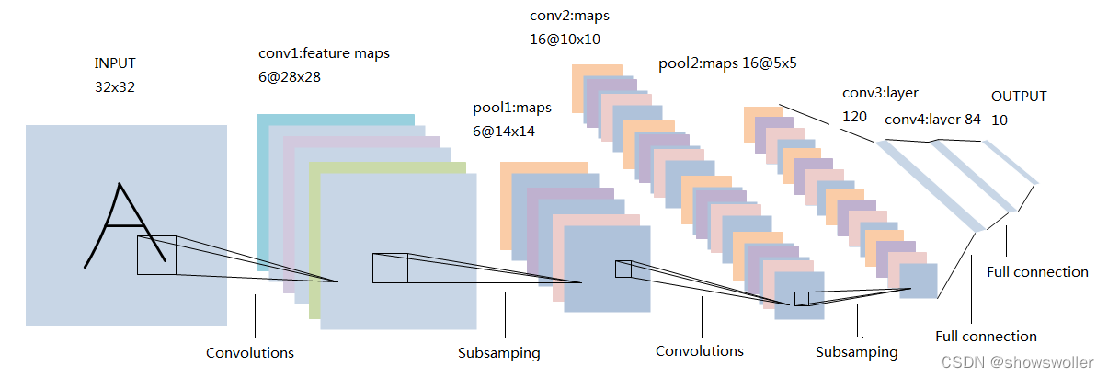OpenCV图像分类:从卷积神经网络到实际应用,掌握图像分类精髓
发布时间: 2024-08-05 12:55:45 阅读量: 21 订阅数: 38 


卷积神经网络(CNN)概念理解

# 1. OpenCV图像分类概述
图像分类是计算机视觉中一项基本任务,它涉及将图像分配到预定义的类别中。OpenCV(开放计算机视觉库)是一个功能强大的计算机视觉库,提供了一系列用于图像分类的工具和算法。
OpenCV中的图像分类方法主要基于卷积神经网络(CNN),这是一种深度学习模型,专门用于处理图像数据。CNN通过一系列卷积和池化层提取图像特征,然后使用全连接层进行分类。
OpenCV提供了一系列预训练的CNN模型,可以用于各种图像分类任务。这些模型包括VGGNet、ResNet和Inception,它们在ImageNet数据集上进行了训练,该数据集包含超过100万张图像,涵盖1000多个类别。
# 2. 卷积神经网络基础
### 2.1 卷积神经网络的结构和工作原理
卷积神经网络(CNN)是一种深度学习模型,专门设计用于处理网格状数据,例如图像。与传统神经网络不同,CNN利用卷积运算来提取图像中的局部特征。
#### 2.1.1 卷积层
卷积层是CNN的核心组件。它由一个过滤器(或内核)组成,在输入图像上滑动,计算每个位置的加权和。过滤器的大小和步长决定了提取特征的粒度。
**代码块:**
```python
import cv2
# 定义卷积层
conv_layer = cv2.dnn.createLayer("Convolution", "conv1", (3, 3), (1, 1), (1, 1), (1, 1))
# 输入图像
input_image = cv2.imread("image.jpg")
# 应用卷积层
output_image = conv_layer.forward(input_image)
```
**逻辑分析:**
* `createLayer` 函数创建了一个卷积层,其中:
* "conv1" 是层的名称。
* (3, 3) 是过滤器的尺寸。
* (1, 1) 是步长。
* (1, 1) 是填充。
* (1, 1) 是组数。
* `forward` 方法将输入图像作为参数,并返回卷积后的输出图像。
#### 2.1.2 池化层
池化层通过将相邻单元格的特征聚合在一起来减少特征图的大小。这有助于控制过拟合并提高模型的鲁棒性。
**代码块:**
```python
import cv2
# 定义池化层
pool_layer = cv2.dnn.createLayer("Pooling", "pool1", (2, 2), (2, 2), "max")
# 输入特征图
input_feature_map = cv2.imread("feature_map.jpg")
# 应用池化层
output_feature_map = pool_layer.forward(input_feature_map)
```
**逻辑分析:**
* `createLayer` 函数创建了一个池化层,其中:
* "pool1" 是层的名称。
* (2, 2) 是池化核的大小。
* (2, 2) 是步长。
* "max" 指定最大池化操作。
* `forward` 方法将输入特征图作为参数,并返回池化后的输出特征图。
#### 2.1.3 全连接层
全连接层是CNN的最后一层,用于将提取的特征映射到输出标签。它与传统神经网络中的完全连接层类似。
**代码块:**
```python
import cv2
# 定义全连接层
fc_layer = cv2.dnn.createLayer("FullyConnected", "fc1", (10, 100))
# 输入特征向量
input_feature_vector = cv2.imread("feature_vector.jpg")
# 应用全连接层
output_vector = fc_layer.forward(input_feature_vector)
```
**逻辑分析:**
* `createLayer` 函数创建了一个全连接层,其中:
* "fc1" 是层的名称。
* (10, 100) 是输入和输出单元格的数量。
* `forward` 方法将输入特征向量作为参数,并返回全连接后的输出向量。
### 2.2 卷积神经网络的训练和优化
#### 2.2.1 损失函数和优化算法
损失函数衡量模型预测和真实标签之间的差异。常见的损失函数包括交叉熵损失和均方误差损失。优化算法用于最小化损失函数,例如梯度下降和动量优化算法。
**代码块:**
```python
import cv2
# 定义损失函数
loss_function = cv2.dnn.createLossLayer("SoftmaxWithLoss", "loss")
# 定义优化算法
optimizer = cv2.dnn.createOptimizer("Adam")
# 训练模型
for epoch in range(10):
# 正向传播
output = model.forward(input_image)
# 计算损失
loss = loss_function.forward(output, labels)
# 反向传播
model.backward(loss)
# 更新权重
optimizer.update(mod
```
0
0





